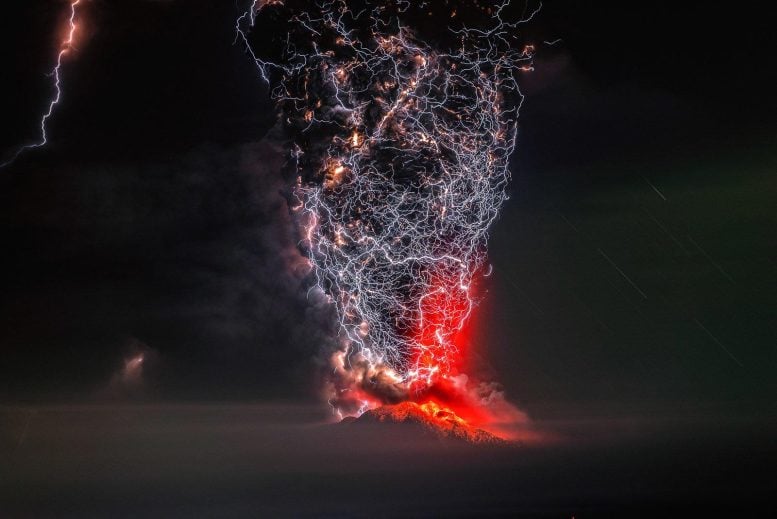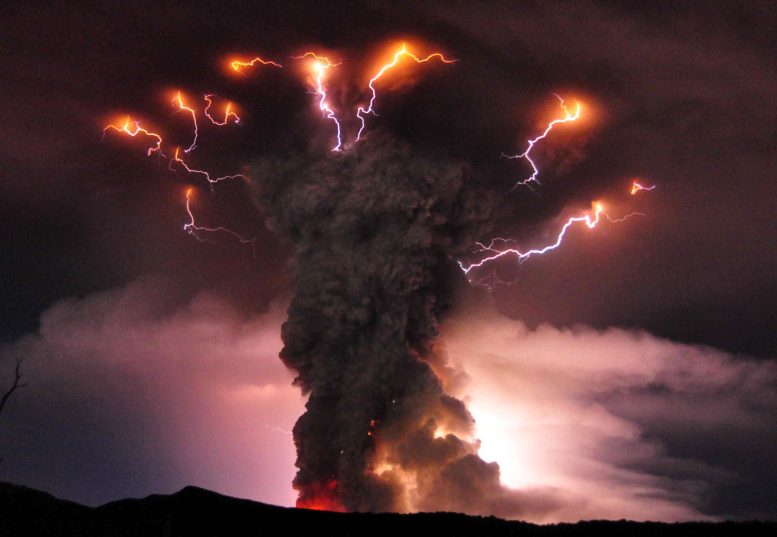
You’ve undoubtedly gazed out of the window to marvel at a lightning storm in all its glory. Thunderstorms are certainly a sight to behold, but another, much less common form of lightning is even more spectacular. As the name suggests, volcanic lightning is a lightning storm that occurs during a volcanic eruption. The science behind why it happens is more complicated than a regular lightning storm.
What Is Volcanic Lightning?
Volcanic lightning occurs in the plume of a volcanic eruption. Like all thunderstorms, volcanic lightning happens when static electricity builds up in the atmosphere before being released in the form of a lightning bolt. However, the static buildup isn’t as straightforward as a typical thunderstorm. While the complete mechanism is not yet fully understood, research shows certain phenomena contribute to the charging.

Ice Charging
Ice charging is the primary mechanism by which regular thunderstorms form, and it also plays a role in volcanic lightning, particularly those where the plume rises high into the air.[1] As the warm air from the eruption rises into the sky, it meets colder air in the atmosphere. The water in the plume freezes into ice particles that collide with one another, knocking electrons from the crystals. These positively charged ice ions continue to rise and congregate higher in the atmosphere.
Frictional charging
Frictional charging, also known as triboelectric charging, is also thought to be a crucial mechanism leading to volcanic lightning.[2] In the same way that ice charging occurs due to ice particles colliding, rock fragments and ash collide and create charged ions. The conventional currents that cause the plume to rise then separate this charge into different regions.
Fractoemission
Similar to frictional charging is fractoemission, which is the breakup of rock particles within the plume. When the rock breaks, it is possible for charged particles to form, forming a buildup of static charge.[3] This effect predominantly occurs at high energy, resulting in the charge congregating closer to the volcano’s vent.
Radioactive charging
Natural radioisotopes within the rock may influence charge buildup. Studies have shown that ash particles have natural radioactivity above the usual level, and charged areas can form when they decay.[4] The extent radioactive charging has on volcanic lightning is unknown, although it may be a significant contributor in some instances.
Plume height
While not a mechanism in its own right, plume height can significantly impact whether lightning occurs.[5] When an eruption results in a tall ash plume (greater than 7 km), there is a higher water vapor concentration. With more water present and colder ambient temperatures at this height, there is likely more ice charging and more electrical activity. For smaller plumes, the suggestion is that most of the electric buildup comes from fractoemission near the vent, reducing the chances of a strike.
While the science behind volcanic lightning is not complete, many factors are known to play a role. More research should hopefully provide a better understanding of what is happening during a strike. Yet, whatever the mechanism, there’s no doubt it’s a spectacular occurrence!
References:
- “Charge mechanism of volcanic lightning revealed during the 2010 eruption of Eyjafjallajökull” by Pordur Arason, Alec J. Bennett and Laura E. Burgin, 14 December 2011, Journal of Geophysical Research: Solid Earth.
DOI: 10.1029/2011JB008651 - “Electrification of volcanic plumes” by T. A. Mather and R. G. Harrison, 20 July 2006, Surveys in Geophysics.
DOI: 10.1007/s10712-006-9007-2 - “Volcanic plume electrification: Experimental investigation of a fracture-charging mechanism” by M. R. James, S. J. Lane and J. S. Gilbert, 10 July 2000, Journal of Geophysical Research: Solid Earth.
DOI: 10.1029/2000JB900068 - “Electrical charging of ash in Icelandic volcanic plumes” by Karen L Aplin, Isobel M P Houghton and Keri A Nicoll, 28 April 2014, Physics > Atmospheric and Oceanic Physics.
arXiv:1404.6905 - “Volcanic lightning: global observations and constraints on source mechanisms” by Stephen R. McNutt and Earle R. Williams, 5 August 2010, Bulletin of Volcanology.
DOI: 10.1007/s00445-010-0393-4
Never miss a breakthrough: Join the SciTechDaily newsletter.
2 Comments
Very Interesting.
1. Lightning = Static Electricity Discharge in the atmosphere
2. Static Electricity can build up in all three evident phases of matter. Solid, Liquid and Gaseous.
a. After reaching a certain level of charge such static electricity forces will find an outlet and discharge.
b. When it discharges in the atmosphere we see the phenomenon as lightning.
c. When it discharges in the solid or liquid phase of matter , we don’t see it as
lightning , but the energy continues to exist. We need to understand this
phenomenon better and in what form this Energy-Matter of statically Charged
Matter-Energy exists.
3. Why do volcanoes erupt? Because of build-up of enormous geological forces deep within the earth and magma seeking release, which we see as release of gasses and lava flowing out, which affect the earths crust (Formation of solid Igneous rocks on cooling).
4. The explanation related to the gases released by the volcanic eruption appears to be appropriate.
5. The question is how do we catch/trap and utilize such energies of Natural Phenomenon like Volcanoes and Cyclones and such, for appropriate use by humans!
Views expressed are personal and not binding on anyne.
My jaw is slack. The aspects of Volcanic Lightning are incredible. I was completely unaware of this type of lightning so to me it’s an OMG moment. So much information, such little time. Thanks for expanding my knowledge base. Michael